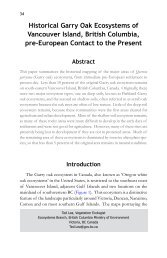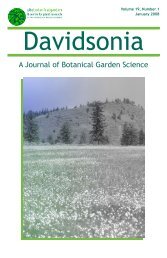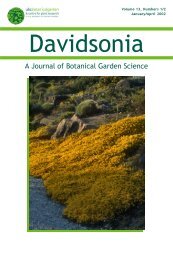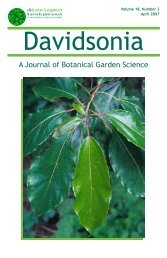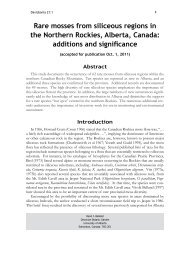pdf wkg Dav.14-14 - Davidsonia
pdf wkg Dav.14-14 - Davidsonia
pdf wkg Dav.14-14 - Davidsonia
Create successful ePaper yourself
Turn your PDF publications into a flip-book with our unique Google optimized e-Paper software.
<strong>Davidsonia</strong> <strong>14</strong>:4<br />
119<br />
There is a simple experiment anyone can do to test and observe these<br />
physiological changes and the effects of the environment on their expression.<br />
This works especially well on species with dramatic autumn changes, such as<br />
Liquidambar styraciflua (sweetgum), Rhus (sumac), Cornus (dogwood) or Acer<br />
saccharum (sugar maple). Before the leaves begin to change colour, cover up<br />
a portion of a leaf, still attached to the tree, with a piece of opaque material,<br />
such as thick paper. Do this on both sides of the leaf and secure it with a<br />
paper clip. An alternative approach is to cover the leaf with an image drawn<br />
in black on transparent film. Wait until the rest of the leaves on the branch<br />
show their autumn pigmentation and remove the masking: the covered<br />
portion should retain the yellow carotenoid colours, and little or no green<br />
since sustained chlorophyll synthesis requires direct light. You can even add<br />
an element of creative design or stencil mysterious messages (Figure 7) along<br />
your favourite wooded trail!<br />
Bibliography<br />
Archetti, M. 2000. The origin of autumn colours by coevolution. Journal of<br />
Theoretical Biology 205:625-630.<br />
Chang, K.-G., Fechner, G.H., and Schroeder, H.A. 1989. Anthocyanins in<br />
autumn leaves of quaking aspen. Forest Science 35:229-236.<br />
Demmig-Adams, B., and Adams, W.W. III. 1992. Photoprotection and other<br />
responses of plants to high light stress. Annual Review of Plant Physiology<br />
and Plant Molecular Biology 43:599-626.<br />
Feild, T.S., Lee, D.W., and Holbrook, N.M. 2001. Why leaves turn red in autumn.<br />
The role of anthocyanins in senescing leaves of red-osier dogwood. Plant<br />
Physiology 127:566-574.<br />
Ford, B.J. 1986. A theory of excretion in higher plants. Journal of Biological<br />
Education 20:251-254.<br />
Gould, K.S., Kuhn, D.N., Lee, D.W., and Oberlauer, S.F. 1995. Why leaves are<br />
sometimes red. Nature 378:241-242.<br />
Greenwood, J.S., Stinissen, H.M., Peumans, W.J., and Chrispeels, M.J. 1986.<br />
Sambucus nigra agglutinin is located in protein bodies in the phloem<br />
parenchyma of the bark. Planta 167:275-278.<br />
Hamilton, W.D., and Brown, S.P. 2001. Autumn tree colours as a handicap signal.<br />
Proceedings of the Royal Society of London, B <strong>14</strong>89-<strong>14</strong>93.<br />
Han, Q., Shinohara, K., Kakubari, Y., and Mukai, Y. 2003. Photoprotective role<br />
of rhodoxanthin during cold acclimation in Cryptomeria japonica. Plant, Cell



